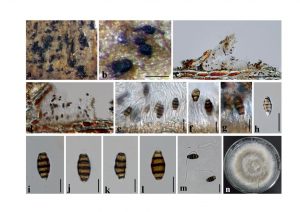Seiridium neocupressi G. Bonthond, M. Sand.-Den. & P.W. Crous, in Bonthond, Sandoval-Denis, Groenewald & Crous, Persoonia 40: 110 (2017)
Index Fungorum number: IF823299, MycoBank number: MB823299, Facesoffungi number: FoF 09147
Saprobic on twigs, branches of dicotyledons. Asexual morph: Conidiomata pycnidial to sporodochial, mostly solitary, immersed, unilocular, conic or subglobose with flattened base, dark brown to black. Conidiomata wall comprising thin-walled cells of textura angularis, sometimes fusing at the base into the host tissue. Conidiophores septate, cylindrical, branched, hyaline or pale brown, thin-walled. Conidiogenous cells annellidic, discrete, hyaline, cylindrical, smooth- and thin-walled, proliferating percurrently, with visible collarettes and minute periclinal thickenings. Conidia 22–28 × 7–9 µm (x̅ = 26 × 8 µm), lunate to falcate, curved, 5-septate, rarely 4- or 6-septate, not striate, occasionally a short apical appendage present, euseptate with no visible pores, basal cell obconic with a truncate base, hyaline, walls smooth, 3.5–4 µm; four median cells, smooth, cylindrical to doliiform, brown to dark brown, and septa darker than the rest of the cells, second cell from base 5–6 µm long, third cell 5–6 µm long, fourth cell 5–6 µm long, fifth cell 4.5–5.5 µm long, apical cell conical, hyaline, smooth, 3.5–4 µm long. Sexual morph: Undetermined.
Culture characteristics – Colonies on PDA reaching approximately 5 cm in diam. after 7 days at 16–18 °C, circular, raised, with a filamentous margin, greyish-white at the center, then dark grey, white at the edge, reverse, greyish-white.
Material examined – Italy, Forli-Cesena Province, near Camposonaldo – Santa Sofia, on dead and land cone of Picea excelsa, 15 April 2015, Erio Camporesi IT2444 (MFLU 15-0813), living culture KUMCC 16-0115.
GenBank Accession numbers – ITS: MN848165, LSU: MN848234, SSU: MN848240.
Known distribution (based on molecular data) – Australia, Italy, New Zealand (Bonthond et al. 2018).
Known hosts (based on molecular data) – Cupressus leylandii, C. macrocarpa, C. sempervirens (Bonthond et al. 2018), Picea excelsa (this study).
Notes – In the phylogenetic analysis, our isolate KUMCC 16-0115 clusters with the type strain of Seiridium neocupressi CBS 142625. Seiridium neocupressi was phylogenetically and morphologically distinct from S. cupressi (Bonthond et al. 2018). The species described (from culture) by Bonthond et al. (2018) has larger conidia (26.5–31 × 8.5–10 µm) compared to our specimen illustrated here (22–28 × 7–9 µm). The morphological features of the conidiophores, conidiogenous cells, conidial septation and shape are similar in both collections. However, we did not observe any basal appendages attached to the conidia in our collection. Seiridium neocupressi is mostly recorded from Cupressus sp. while our collection from Italy is on Picea excelsa. This is the first record of a Seiridium species from this host.

Fig. Seiridium neocupressi (MFLU 15-0813, new host record). a Conidiomata on host. b Close up of conidiomata. c, d Section of conidioma. e–g Conidiophores with conidia. h–l Conidia. m Germinating conidia. n Culture on PDA. Scale bars: c, d = 1 mm, e, m = 50 µm, f–l = 20 µm.
